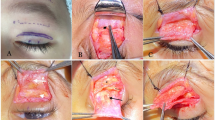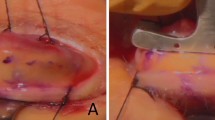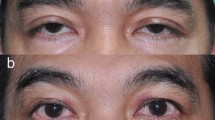Abstract
Purpose We describe a surgical technique for ptosis correction in moderate to good levator function involving resection of Müller's muscle of the upper eyelid. This is a substantial modification of the technique described by Putterman. We then present our experience of and the results from this method.
Methods A subtotal resection of Müller's muscle plus underlying conjunctiva is performed under direct visualisation. The muscle stump is reattached to the tarsus and the sutures passed through to the skin crease. In those cases where the phenylephrine test was positive to a level less than the desired lid height, a 1 mm of strip of tarsus is included in the tissue resection. The sutures are removed between 5 days and 3 weeks postoperatively allowing control over lid height and contour. A total of 61 eyes of 48 patients underwent this procedure.
Results Of 61 eyelids, 56 undergoing this procedure were within 0.5 mm of the desired end point, giving a success rate of 92%. Of 61 eyelids, 60 were within 1 mm of the desired height. Preoperative phenylephrine 10% was highly predictive of postoperative lid height (58/61). An excellent lid contour was noted in all cases (61/61).
Conclusions We present a new approach to ptosis correction using Müller's muscle. It has a high success rate and good cosmetic outcome. It is technically straightforward and easy to learn.
Similar content being viewed by others
Introduction
Müller's muscle was identified in 18691 and further characterised by Beard2 in 1983. It arises from the under surface of the levator muscle, and inserts onto the superior border of the tarsus, positioned directly under the levator aponeurosis. It transfers the contraction of the levator to the tarsus, maintaining lid position, by acting in series with the levator muscle and in parallel with its aponeurosis. It has only recently been appreciated how important it is in the control of lid position, acting as a muscle spindle generating a stretch reflex for the levator muscle.3
Conventional ptosis surgery in the presence of a functioning levator muscle is now predominantly on the aponeurosis of the levator complex. This is usually successful but can produce unusual lid contours, and care is required to exclude or treat high aponeurosis defects to avoid surgical failure.
The Fasanella–Servat procedure is another technique to correct ptosis via the posterior approach.4 It is only suitable for mild ptosis of less than 3 mm.5 Histopathology of the excised tissues has shown that usually tarsus is excised with no or minimal Müller's muscle.6 This may produce instability of the upper lid or poor lid contour.
Putterman developed a technique of excision of Müller's with preservation of the tarsus.7 Müller's muscle is dissected blindly off its bed on the aponeurosis, excised with the use of a special clamp, and closed on the conjunctival surface. It is suitable for ptosis correction where the ptosis responds to 10% phenylephrine instilled into the upper fornix, although 2.5% phenylephrine has been shown to be as effective.8
We present here a modification of this technique with direct visualisation of Müller's muscle before its resection, and the use of sutures passed through to the skin crease. These sutures advance the levator muscle to the tarsus, bypassing any aponeurotic defects, high or low, and allow both per- and postoperative modification of lid height.
Surgical technique
The procedure is usually performed with minimal local anaesthesia without adrenaline (Figure 1a). The skin crease is marked to the desired height, the lid everted by traction with a 4/0 prolene lid margin suture over a Desmarres retractor, and tarsus marked at its upper border (if the preoperative phenylephrine test produces a low upper lid position, the tarsus is marked at the level of the skin crease, to resect 1 mm of tarsus to raise the lid further).
Surgical technique illustrated: (a) local anaesthetic infiltration, (b) Müller's muscle stripped from the aponeurosis, (c) subtotal resection of Müller's muscle. (d) 5/0 silk passed through forniceal conjunctiva, Müller's muscle stump, the upper border of tarsal plate (e), and through to the skin crease (f). Two further double-ended 5/0 silk sutures are passed (g), and tied over cotton bolsters (h,i).
By cutting through the upper border of the tarsus, the plane between Müller's muscle and the aponeurosis is easily identified. Müller's muscle is stripped cleanly from the aponeurosis (Figure 1b) and a subtotal resection performed (Figure 1c), leaving a stump of the muscle in the upper fornix 1–2 mm long. Haemostasis is obtained by appropriate use of cautery.
Three double-ended 5/0 silk sutures are passed through the cut edge of forniceal conjunctiva, Müller's muscle (Figure 1d), and the upper border of the tarsus (Figure 1e) through to the skin crease marked earlier (Figure 1f). The cardinal (central) suture can be tied in a loop and the lid height assessed. This allows peroperative adjustment of lid height and contour. If one is unable to achieve the desired lid position by these means, aponeurosis is opened from the same approach and the procedure converted to a posterior approach levator resection. Once satisfactory lid height and contour is achieved, all three sutures are tied over small cotton bolsters (Figure 1g–i).
A pressure dressing is applied for 24 h. The sutures are removed between 5 days and 3 weeks postoperatively according to the lid height and amount of swelling present.
Patients and results
In total, 61 eyes of 48 patients underwent conjunctiva– Müller's resection for ptosis between December 2000 and April 2002. The mean age was 54 years with a range of 4–80 years old. Preoperatively, MRD1 ranged from −1 to 3.5 mm, with levator function 9–14 mm.
Initially, our primary selection criterion was that the eyelid responded within 5 min of instillation of one drop of phenylephrine 10% into the upper fornix with correction of the ptosis. In 32, the phenylephrine test produced a lid position at or ±0.5 mm from the limbus. In a further 23, phenylephrine 10% raised the lid to a position 0.5 to 1mm below the limbus, and in four cases to 0.5 to 1 mm above the limbus. Late in the series, we also performed this procedure on two cases that did not respond to phenylephrine 10%.
In all, 55 had no previous surgery, six had previously undergone anterior levator resection. A total of 33 were involutional (senile aponeurotic) ptosis, two congenital Horner's syndromes, eight congenital ptosis (dystrophic), three anophthalmic sockets, and 15 related to contact lens wear or previous surgery (Figure 2). In total, 13 patients had bilateral ptosis surgery (in 15, the phenylephrine test demonstrated bilaterality and the patients were warned of the possible need to have both sides corrected).
General anaesthesia was used for 10 eyelids (five children), and local anaesthesia for the remaining 51. Two patients developed a corneal abrasion postoperatively, which healed rapidly with adequate lubrication. The pattern of abrasion was consistent with peroperative surface drying rather than problems with the sutures looped through the conjunctival surface, and healed before suture removal.
In 49 cases, the final lid position was exactly as desired. Two were 0.5 mm overcorrected, and five were 0.5 mm undercorrected. One was 1 mm overcorrected, and three were 1 mm undercorrected. Allowing a margin of error of ±0.5 mm gives a success rate of 92%. Only one case was more than 1 mm from the desired end point and therefore considered a complete failure. This was a congenital dystrophic ptosis undertaken early in our series, which was phenylephrine positive, had previously undergone an anterior levator resection (ALR), and considerable scarring was noted during the operation. This patient is now awaiting a repeat ALR.
All patients had an excellent lid contour. Follow-up ranges from 6 months to 2 years. In none of the cases did we convert to posterior levator resection.
Discussion
Müller's muscle has always been known to be unusual as a smooth muscle anatomically and functionally closely linked to a striated muscle. It has only recently been appreciated how important it is in the control of lid position, acting as a muscle spindle generating a stretch reflex for the levator muscle.3 Altering that stretch reflex to increase levator tone therefore seems an attractive option in correcting ptosis—and was attempted even before a full understanding of the stretch reflex.9 The Fasanella–Servat is a blind approach only suitable for mild ptosis, and rarely excises Müller's muscle.6 Putterman's technique is more precise in that Müller's is pulled off the underlying levator, but still requires a clamp and does not allow direct visualisation of Müller's in its separation from levator.7 Closure on the conjunctival surface may irritate the surface of the eye and does not allow per- or postoperative adjustment.
The technique presented here allows direct visualisation of concerned tissues. By cutting through the upper border of the tarsus, one enters a potential space between the smooth muscle and the aponeurosis. It is easy to dissect Müller's muscle free of the aponeurosis in this tissue plane, often just by blunt dissection using a cotton bud. Lid anatomy is clearly demonstrated. The aponeurosis is not disturbed.
While nomograms exist when using Putterman type conjunctiva– Müller's technique allowing titration of the amount excised to the degree of ptosis,10,11,12 it has also been shown that excising 9 mm raises the upper lid to the position produced preoperatively by 10% phenylephrine instilled into the upper fornix.7 Our subtotal resection of Müller's muscle is approximately equivalent to a 9 mm resection and therefore the phenylephrine test was initially used to predict final lid height. However, per operative adjustment (when performed under local anaesthesia) allows further resection of Müller's if undercorrected, and postoperative timely removal of sutures allows adjustment if overcorrected. This is the principal technical advantage of this procedure over clamp resection as described by Putterman.
There are two possible explanations for the effect of this technique on ptosis. It is surmised that subtotal resection of Müller's muscle (9 mm of its standard 11 mm length) enhances the stretch reflex transmitted to the levator. Histologically, Müller's muscle becomes thinner, more elongated, and has more fat infiltration with increasing age,13 and it may be that this procedure somehow resets the stretch reflex and enhances levator tone. This would not account for its success in aponeurotic dehiscence however. By passing the sutures through the stump of Müller's muscle (which originates from the lower border of the levator muscle) and then through the tarsus, one is in effect advancing the levator and attaching it to the tarsal plate and skin crease. This transmits the force of the levator to the tarsal plate, bypassing the aponeurosis and any potential defects in it, high or low. We feel this latter explanation accounts for the success of the procedure. It also demonstrates the advantage of Müller's muscle resection in high aponeurotic defects.
Two of our cases were phenylephrine negative with 9 mm levator function. This procedure was performed as a prelude to posterior approach levator resection. Per operatively, it was found that conjunctiva–Müller's muscle resection alone achieved excellent height and contour negating the need to operate on aponeurosis. One possible explanation for the negative phenylephrine test is degenerative sympathetic denervation of Müller's as both these cases had very fatty Müller's muscle. Shortening Müller's muscle in these cases, however, has the same advancing effect on the levator. We therefore feel that the operation could be successful on many phenylephrine-negative cases. A study looking at this is underway in our unit. A positive phenylephrine test, however, was indicative of final lid height in 58 out of 59 cases.
Complications were few in this series. Only two patients developed a corneal abrasion as noted above. Excision of conjunctiva does risk shallowing the upper fornix and damage to accessory tear glands, particularly the glands of Wolfring, which are situated at the upper tarsal border. In cases where there is a particular concern over fornix shallowing, such as anophthalmic sockets, conjunctiva could theoretically be stripped from Müller's and a pure Müller's resection performed. None of our patients had or developed any signs or symptoms of dry eye.
Similarly, we have had no problems with upper lid entropion. We believe that passing the suture through the upper border of tarsus to the skin crease has an everting action on the upper lid, maintaining lid stability and position.
We have had an excellent success rate with this procedure with only one eyelid requiring further surgery. This compares to 2/77 in a series of ptosis correction using Putterman's technique needing further correction14 and 24/207 for ALR15 (Table 1). In all, 98% of our eyelids were within 1 mm of the desired height, which compares to 94% for Putterman16 and 74% with the ALR.17 We attribute this to our ability to modify the eyelid position both preoperatively and postoperatively by appropriately timed suture removal. None of these cases required peroperative conversion to posterior levator resection.
This technique is easy to teach and learn. It avoids the need for a clamp during surgery.9 As Müller's muscle lies directly under the conjunctiva, the tissues are easily identifiable with no chance of ‘getting lost’ during surgery. The anatomy is easy to see and appreciate, and in contrast to levator resection always seems to produce a good contour. It allows per- and postoperative control of lid height, reattaches the levator to the skin crease, and we have demonstrated here its predictability and excellent success rate.
References
Müller H . Uber glatte Muskeln an der Augenlidern des Menschen und der Saugetiere, Vol. IX. Verhandl PMG: Wurzberg, Germany, 1859, p 244. Cited by: Whitnall SE. The anatomy of the Human Orbit, 2nd ed.Oxford University Press: London, UK, 1932.
Beard C . Müller's superior tarsal muscle: anatomy, physiology, and clinical significance. Ann Plast Surg 1985; 14: 324–333.
Matsuo K . Stretching of the Müeller muscle results in involuntary contraction of the levator muscle. Ophthalmic Plast Reconstr Surg 2002; 18(1): 5–10.
Fasanella RM, Servat J . Levator resection for minimal ptosis: another simplified operation. Arch Ophthalmol 1961; 65: 493–496.
Betharia SM, Grover AK, Kalra BR . The Fasanella–Servat operation: a modified simple technique with quantitative approach. Br J Ophthalmol 1983; 67: 58–60.
Buckman G, Jakobiec FA, Hyde K, Lisman RD, Hornblass A, Harrison W . Success of the Fasanella–Servat operation independent of Müller's–smooth muscle excision. Ophthalmology 1989; 96: 413–418.
Putterman AM, Urist MJ . Müller muscle conjunctiva resection: technique for treatment of blepharoptosis. Arch Ophthalmol 1975; 93: 619–623.
Glatt HJ, Putterman AM, Fett DR . Comparison of 2.5% and 10% phenylephrine in the elevation of upper eyelids with ptosis. Ophthalmic Surg 1990; 21: 114–122.
Putterman AM . A clamp for strengthening Müller's muscle in the treatment of ptosis: modification, theory, and clamp for Fasanella–Servat operation. Arch Ophthalmol 1972; 87: 665–667.
Weinstein GS, Buerger Jr GF . Modifications of the Müller's muscle conjunctival resection operation for blepharoptosis. Am J Ophthalmol 1982; 93: 647–651.
Guyuron B, Davies B . Experience with the modified Putterman procedure. Plast Reconstr Surg 1988; 82: 775–780.
Dresner SC . Further modifications of the Müller's muscle conjunctival resection procedure for blepharoptosis. Ophthalmic Plast Reconstr Surg 1991; 7: 114–122.
Collin JR, O, Beard C, Wood I . Experimental and clinical data on the insertion of the levator palpebrae superioris muscle. Am J Ophthalmol 1978; 85: 72–801.
Mercandetti M, Putterman AM, Cohen ME, Mirante JP, Cohen AJ . Internal levator advancement by Müller's muscle–conjunctival resection: technique and review. Arch Fac Plast Surg 2001; 3: 104–110.
Shore JW, Bergin DJ, Garrett SN . Results of blepharoptosis surgery with early postoperative adjustment. Ophthalmology 1990; 97: 1502–1511.
Putterman AM, Urist MJ . Müller's muscle–conjunctival resection ptosis procedure. Ophthalmic Surg 1978; 9: 27–32.
Berlin AJ, Vestal KP . Levator aponeurosis surgery. A retrospective review. Ophthalmology 1989; 96: 1033–1036.
Author information
Authors and Affiliations
Corresponding author
Rights and permissions
About this article
Cite this article
Lake, S., Mohammad-Ali, F. & Khooshabeh, R. Open sky Müller's muscle–conjunctiva resection for ptosis surgery. Eye 17, 1008–1012 (2003). https://doi.org/10.1038/sj.eye.6700623
Received:
Accepted:
Published:
Issue Date:
DOI: https://doi.org/10.1038/sj.eye.6700623
Keywords
This article is cited by
-
Anterior approach white line advancement: technique and long-term outcomes in the correction of blepharoptosis
Eye (2017)
-
The 90-degree rule in posterior ptosis surgery
International Ophthalmology (2016)
-
Minimal incision posterior approach levator plication for aponeurotic ptosis
Eye (2015)
-
Open-sky isolated subtotal Muller’s muscle resection for ptosis surgery: a review of over 300 cases and assessment of long-term outcome
Eye (2013)
-
Isolated Muller's muscle resection for the correction of blepharoptosis
Eye (2008)





